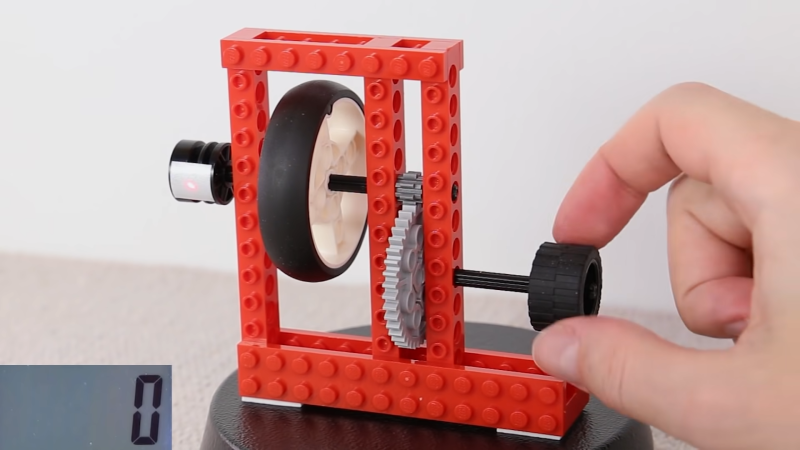It’s not a question you ask yourself every day, but it’s one that the [Brick Experiment Channel] set out to answer: how fast can you spin a LEGO wheel by hand? In their typical way, they set about building an increasingly complex contraption to optimize for the very specific case of maximum RPM.
The build starts with a LEGO wheel fitted to an axle, supported in two LEGO Technic beams. A white flash mark is also attached onto a part of the axle for measuring the rotational speed with a photo-tachometer. A first attempt gets as fast as 1,700 RPM. Upgrades come thick and fast , and with a three-stage compound geartrain, the handcranked wheel reaches 6,300 RPM. Adding a further stage introduces the problem that the plastic Technic axle begins to twist under the torque input by the hand.
Taking a new approach of pulling on a string to turn the wheel, the first attempt nets 8,300 RPM. Gearing pushes this further to 12,900 revs, but adding more gears again leads to the problem of axles bending under the strain. A bidirectional rope pull design helps, though, and the system reaches 13,100 RPM.
Some of the parts have been damaged thus far, but a rebuild with fresh parts that are nicely lubricated provides a huge boost. The now-slippery shafts run smoother and the wheel hits a blistering 19,300 RPM as the mechanism disassembles itself.
It’s a less complex pursuit than some earlier works from [Brick Experiment Channel], like the impressive pole climbing designs we’ve seen previously. However, it’s a video that shows the power of iterative design and the gains possible from that process.















Just going to leave this here… https://m.youtube.com/watch?v=JZHPXTd4xd0
Vague memory that Lego tires come off the wheels if you spin them too fast. Quite amusing the first time it happena with a large one in a small room!
I am surprised he didn’t try the steel axles like he did in an earlier video ( https://www.youtube.com/watch?v=jRn5waE0qfk ).
@Caesar said: “I am surprised he didn’t try the steel axles like he did in an earlier video ( https://www.youtube.com/watch?v=jRn5waE0qfk ).”
That video is from Mar 14, 2020. This video (below) titled “Testing a Lego-compatible Steel Axle” from Feb 2, 2019 predates that one. Also, the video from 2019 has links where the steel axle came from. I tested the two links, one is broken and the other wouldn’t load for me. However, a brief web search turned up two new sources for metal Lego axles:
1. A range of metal Lego Technic compatible axles where high stiffness and length is needed.
https://metal-technic-parts.com/collections/axles
2. 7x Metal Axle Shaft Rod fits / for Lego Technic 7 Pcs Assorted Heavy Duty X beam
https://www.ebay.com/itm/7x-Lego-Technic-Style-Metal-Axle-Shaft-Rod-7-Pieces-Assorted-Heavy-Duty-X-beam/123654923448
Here’s the 2019 video: https://www.youtube.com/watch?v=jpJIhxE1iQk
https://www.youtube.com/watch?v=jpJIhxE1iQk
I guess once you’re using non-official Lego steel axles, why not start using steel cogs as well, then you might as well replace the connectors with proper bearings, and soon enough you have something with practically no actual Lego at all.
I think [Brick Experiment Channel]’s philosophy is to only use and test genuine Lego wherever possible.
I remember a LEGO project that used a pair of fast spinning wheels to launch AOL CDs. It was able to throw the CDs clear across a sizable room, quite impressive!
I did something similar in the 1980’s, building tiny lego piston engines and trying to see how fast I could spin them. There were some very early lego gears that were comparatively huge, like 30-60mm in diameter, with big paddle-shaped gear teeth, that were easy to repurpose as turbines with an air compressor stream blowing them.
In my experience, even at 1000 rpm the lego axles melted from friction and the whole works came to a terrible stop. Similarly, the pistons rubbing against the cylinder walls (at the time the only option was 2×2 square pistons) had enough friction to melt and weld together.
I was interested in measuring how good an air pump you could make, knowing that if you increase pumping speed enough you don’t have to worry a lot about how well the pistons seal. Based on those experiments, it didn’t look like high speed was going to work either, so then it was just add more pistons for the highest speed it could tolerate without wearing too badly, if I needed to increase airflow.